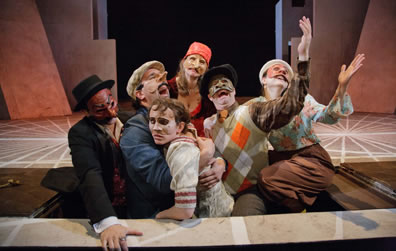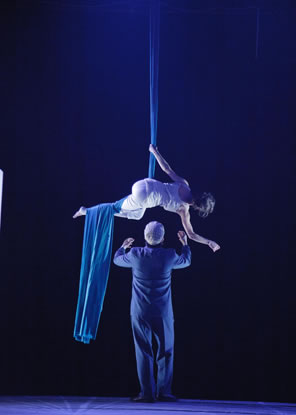Hamlecchino, Clown Prince of Denmark
Hamlet Was Wrong: Anything So Overdone
Can Be to the Purpose of Playing
Faction of Fools Theatre Company, Gallaudet University Elstad Auditorium, Washington, D.C.
April 26, 2012, C–1&2 right stalls
Directed and Choreographed by Matthew R. Wilson

Ophelia (Emma Crane Jaster, center) is joined in her gave by the excessively grieving Danish court in the Faction of Fools production of Hamlecchino, Clown Prince of Denmark. From right: Billy Finn as Claudius, John V. Bellomo as Laertes (holding Ophelia), Eva Wilhelm as Gertrude, Matthew R. Wilson as Hamlet, and Rachel Spicknall as Horatio. Photo by C. Stanley Photography, Faction of Fools.
Ophelia was not laid in her grave. Her brother, Laertes, instead carried her down into the pit, and with the Faction of Fools performing a commedia dell’arte version of Hamlet, you just knew Shakespeare’s most absurd scene in this play was about to get more absurd. Sure enough, Hamlet and Laertes fought in the grave using Ophelia’s hands to slap each other’s faces and poke each other’s eyes. Then they left her body draped over the front skirt of the stage.
With Hamlecchino, Clown Prince of Denmark, Faction of Fools was not necessarily doing something new with Shakespeare’s most famous play; rather, they were attempting to make the play even older than it is. This theater company specializes in commedia dell’arte, the Renaissance Italian theatrical form with players wearing caricaturish masks performing comically stylized stock characters. It became popular in London by the 1560s and much evidence suggests it influenced Shakespeare. Faction of Fools demonstrated how in its hugely successful A Commedia Romeo and Juliet earlier this year. The form would also readily apply to such early plays as Comedy of Errors, Two Gentlemen of Verona, and Richard III, and I could see The Taming of the Shrew being done with the Induction performed straight and the play proper performed as commedia dell’arte. Even a late play such as Cymbeline, with its tragicomic conventions and archetype characters, would lend itself to the commedia treatment.
Hamlet, however, is a stretch, far beyond the bounds the company knew it was o’erleaping when it decided to tackle this play. In his director’s notes, Matthew R. Wilson, who also played Hamlet, demonstrates how Shakespeare’s characters track with commedia stock characters: the put-upon patriarch (the Ghost), the randy wife (Gertrude), the charismatic interloper (Claudius), the babbling advisor (Polonius), the young lovers (Ophelia and Laertes), and the clever servant who schemes out the plot to set all right (Hamlet). Still, even if elements of commedia crept into Shakespeare’s play, Hamlet is something of an art form in and of itself. It can only be categorized as Shakespearean, and no matter what form this play is translated to, be it Broadway musical, radio play adaptation, or this commedia dell’arte version, the result will always be something less than the two versions of the Hamlet Shakespeare gave us.
This is not, however, to denigrate Hamlecchino anymore than saying it is not really Hamlet. Not only is it great theater in its own right, Shakespeare purists would do well to put aside their prejudice against nontraditional stagings and check out this production, for it offers many insights into the characters and their lines. They will also see a truly great Hamlet in Wilson.
Wilson’s expertise in commedia dell’arte is unquestionable: he has even taught the form in Italy. With this performance of Hamlet, he reveals himself to be an expert in Shakespearean verse, too. Marrying his commedia choreography and comic emphasis to his verse-speaking abilities and Shakespearean sensibilities, Wilson played the soliloquies, in particular, with wholly fresh takes on lines we all know so well. Ironically, though overemphasizing gestures and inflection and wearing a mask, Wilson demonstrated Hamlet’s soliloquies to be craftily written trains of thought that wend their own way and sometimes jump tracks, i.e., Shakespeare’s genius in genuinely portraying meditation. Wilson also removed the conundrum of the “Rogue and peasant slave” soliloquy by excising any notion that Hamlet had already settled on the play as the thing to catch the conscience of the king. With the idea as obvious as the nose on his mask, Wilson turned the “Fie upon’t, foh! About, my brain!” line into an extended psychological comic interaction with the audience.
Acknowledging the fact this is a play before an audience rather than accurate representation of real life is a common ingredient of the commedia dell'arte. Finn's Claudius even consulted with one of the audience's sign language interpreters during his attempt-at-prayer soliloquy. Other commedia conventions are stylized movements and postures, extracurricular slapstick acrobatics, and the masks, here created by Aaron Cromie with such detail—Ophelia’s even had a mole on hers—they seemed genuinely expressive. Other commedia choices actually altered the plot. The climactic fencing bout was played entirely for laughs, and the clever choreography of Hamlet and Laertes (John V. Bellomo) exchanging rapiers was inspired hilarity; however, it resulted in a wholly un-Shakespearean comic demise for Claudius (Billy Finn). The players became one player, but that one player, David Gaines, used a clever succession of primitive masks to portray different parts, and rather than speaking the Priam and Hecuba speech, he mimed it, replacing Shakespeare’s great moment of pathos with Gaines’ brilliantly funny dumb show. Horatio was played by Rachel Spicknall as a woman who has a crush on Hamlet, which altered the shadings of the Prince-commoner relationship Shakespeare wrote into their scenes.
Most notable was a play-long gag inspired by casting Gallaudet University students Amelia Hensley and Marianna Devenow as Rosencrantz and Guildenstern, respectively. Hamlet’s journey to England was totally dropped, so Rosencrantz and Guildenstern didn’t end up dead. Instead, the famous line about their demise became a groaner of a pun. Their use of American Sign Language also became a comic set piece: Hamlet, their old friend, signed fluid ASL, but the clueless king and queen translated their conversations into sexually suggestive gestures, and Polonius (Toby Mulford) used what can best be described as pidgin ASL in his description of Hamlet as mad that was the production’s funniest moment, mutually appreciated by hearing and hearing-impaired audience members alike.

Emma Crane Jaster (Ophelia) and John V. Bellomo (Laertes). Photo by C. Stanley Photography, Faction of Fools.
Mostly, though, the production mined the comedy already rife in Shakespeare’s original text; we just don’t always see the breadth and depth of that comic vein in other productions. Even the Ghost proved inherently funny. Gaines’ Ghost alternated his voice between an otherworldly specter—“My hour is almost come, when I to sulphurous and tormenting flames must render up myself”—and that of an impatient grandpa grown cynical—“Pity me not but lend thy serious hearing to what I shall unfold.” (Kudos to this production, too, for using multiple actors playing the Ghost to create the “’Tis here! ’Tis here!” sequence in the opening scene.) The Ghost also waggled his hand when describing his “most seeming-virtuous queen,” and as we’d already met this sex-addicted woman, played by Eva Wilhelm, we understood the Ghost’s meaning. In the closet scene when Hamlet compares the pictures of his dead father and uncle, Gaines’ Ghost and Finn’s Claudius themselves played those pictures.
For all the comedy gleaned from this tragedy, and Hamlet seeming something closer to George Carlin doing a stand-up routine than the melancholy Dane speaking a soliloquy, Wilson in both his playing and direction was ever-respectful of Shakespeare’s poetry. As Wilhelm’s Gertrude solemnly recounted Ophelia’s death, Emma Crane Jaster playing Ophelia performed an aerial ballet sheathed in water-emulating fabric that was as visually powerful as the spoken speech. Jaster also used her acrobatic skills and beautiful singing voice to great effect in the mad scenes, plucking and presenting invisible flowers with her feet. Was the audience’s collective gasp in reaction to the humor portrayed there, Laertes’ agony, or Jaster’s skill? It was for all three at once. After the levity of the final scene, the production ended with a visual image emphasizing that for all the fun we’d been having, this really was The Tragedy of Hamlet, Prince of Denmark.
No, it’s not Shakespeare’s Hamlet, per se. It is Hamlecchino, Clown Prince of Denmark, a commedia Dell’ Arte version of Shakespeare’s version of an ancient story the Bard composed at the height of his creative and story-telling powers. Still, the genius of this production was clearly inherited from its progenitor.
Eric Minton
May 1, 2012
Special note
While I considered this essentially a different version of Hamlet from Shakespeare's, Sarah, my wife, proclaimed it her second favorite Hamlet she has seen, ranking it only behind the American Shakespeare Center version at the Blackfriars last year (which, ironically, I called “The Clown Prince of Denmark” in my Shakespeareances.com review). Consider that her proclamation came from one who once doted on Kenneth Branagh, and just a few days before seeing this production she watched the BBC Hamlet with Derek Jacobi. That is testimony to Wilson's portrayal of the prince; it is also testimony to the fact she prefers her Hamlets sly and sardonic rather than pathetic.
This review also appears on PlayShakespeare.com
Comment: e-mail editorial@shakespeareances.com
Start a discussion in the Bardroom



 Find additional Shakespeareances
Find additional Shakespeareances